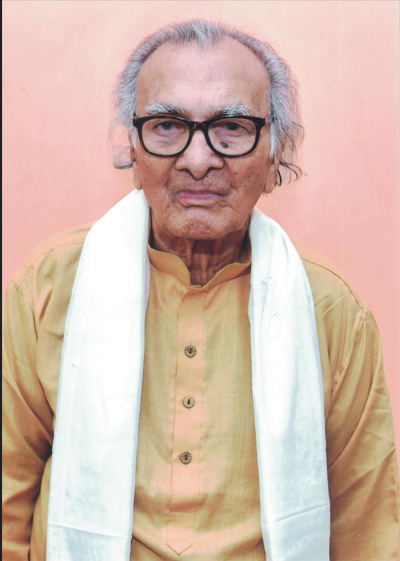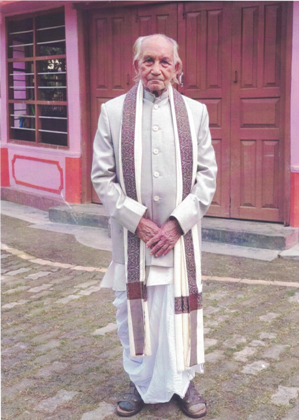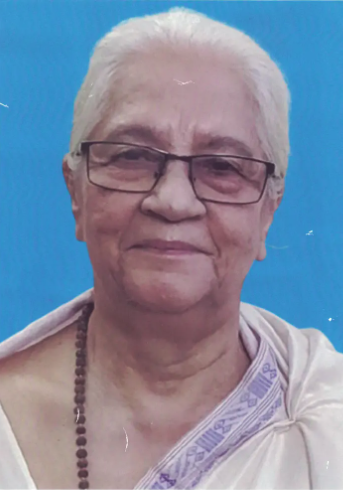Ministry of Home Affairs
The President of India confers Padma Bhushan to Shri Jatin Goswami and Padma Shri to Shri Reba Kanta Mahanta and Ms. Gita Upadhyay in the field of Art, Art and Literature and Education respectively from Assam during Civil Investiture Ceremony
प्रविष्टि तिथि:
27 MAY 2025 8:15PM by PIB Guwahati
The President of India Smt. Droupadi Murmu conferred Padma Bhushan to Shri Jatin Goswami and Padma Shri to Shri Reba Kanta Mahanta and Ms. Gita Upadhyay in the field of Art, Art and Literature and Education respectively from Assam during Civil Investiture Ceremony today.
Brief citation about the life and work of the awardees is given below:

SHRI JATIN GOSWAMI
Shri Jatin Goswami, founder and Chief Director of Sattriya Akademi, a pioneer institute of Sattriya Dance in Guwahati is a veteran Sattriya dance exponent who is widely recognized for his role in growth and development of Sattriya dance. He has made the dance form popular inside and outside Assam.
Born on 2nd August, 1933, Shri Goswami started receiving basic education of Sattriya culture under the guidance of his father who was also one of the great Sattriya artistes of his times. He learned Sattriya dance under the guidance of Sangeet Natak Akademi Award winners, Late Maniram Dutta Muktiar and Late Roseswar Saikia Bar Bayan hailed from Sri Sri Kamalabari Sattra. He became well trained up in the multi coloured Assamese folk songs, dances and Ankia Nat (Bhaona) under the guidance of Kalaguruv Bishnu Prasad Rabha. He first presented Ankia Nat in modern stage and he is the first and only person to form mobile cultural group for performance of Sattriya dance and Ankia Nat Bhaonas. He also imparted training of Sattriya dance to various mobile theater groupsof Assam.
Shri Goswami founded Pragjyoti Kala Parishad, a Cultural organization under the guidance of KalaguruBishnu Prasad Rabha. With this organization,he visited every Sattra (monastery) and Namghar of Assam and gathered a number of practical knowledge about Sattriya dances and dramas. He visited different parts of the country, performing Sattriya dance. He became most respected seniormost Sattriya dance Guru. He is the pioneer in experimentation and composition of Sattriya dance.
Shri Goswami articulated and designed several compositions of Sattriya dance, for which the dance form has got immense popularity. He has led key initiatives for promoting the danceform. He served as a member of the General Council of Sangeet NatakAkademi, New Delhi. He was also a member of the Expert Committee of I.C.C.R, North East Zonal Cultural Centre, Etc.
Shri Goswami is the recipient of numerous awards and honours. The Government of India conferred on him Padma Shri in 2008. He received Sangeet NatakAkademi award in 2004 for his outstanding contributions to Sattriya dance. The Government of Madhya Pradesh conferred on him Kalidas Samman in 2017. He has been conferred Akademi Ratna (Fellow) by Sangeet NatakAkademi, New Delhi in 2019. In 2002 he was honoured with Bharatiyam Samman by E.Z.C.C. Department of Tourism and Culture, Government of India. He was awarded with Best Dance Director award by Government of Assam for 1997-98.

Shri Reba Kanta Mahanta
Shri Reba Kanta Mahanta, the Sattradhikar of KhatparSattra, Sibsagar,Assam is known for dedicating his life in the services of sattras and Sattriya Culture and occupies a distinguished place in Satriya mask making and promoting Mukha Bhaona (a dance drama where the actors play their roles wearing mask).
Born on 19th April, 1935, Shri Mahanta learnt the art of making masks and performing Mukhabhaona from his sattradhikar father. He took initiative to establish Hahchara Girls' High Schooland retired as a Head Master in 1996. He served the District Sattra Mahasabha as General Secretary for 27 years and President for 2 years. He is life time member of Asom Sahitya Sabha and Satra Mahasabha. He has written many articles on religion, culture and mask making in various newspaper, magazines and souvenirs.
Shri Mahanta has established a unique museum in his own Satra campus which reflects the artefacts, musical instruments and masks etc. related to Satriya Culture and this museum attracts the footfalls of different visitors and tourists from different places of the state and country and even from abroad also. His artistic creations are also being displayed and demonstrated in different institutes, museums and universities etc. In 1989 on invitation of Craft Council of India, he took part in Exhibition cum Workshop at Eden Garden, Kolkata about mask making and its uses and from the exhibition 5 masks were taken to distant Russia and Japan to preserve in their museums. His masks were procured by Indian Museum, Kolkata; National Museum, Washington and IGNCA, New Delhifor preservation in their respective museums. In 2016, Tezpur Central University procured one huge mask of Narasingha (Bormukha) for demonstration and preservation in its museum. In 2017 by using different types of masks, he built a Welcome Gate at Lokpriya Gopinath Bordoloi International Airport, Guwahati which wore a global look at that time. In 2018, Australia procured 2 masks for demonstration and preservation in their museums.
As an expert master artist and instructor, Shri Mahanta showcased his performances and conducted different workshops in different parts of the country such as “Ram Vijoy” Bhaona in Delhi and Vrindavan (1975); NE India cultural function (1976); Khol- Ba Don and Chordhora Bhaona in All India Radio, Dibrugarh (1998); at Srimanta Sankaradeva Kalakshetra (SSKS),Panjabari,Guwahati,Assam (1999).In 2004, he was invited to International Ramayana Festival,Trivendrum and demonstrated two Ankla Bhaona viz.Kiskindhya Kanda and SundaraKanda. In 2010, he performed ShyamantaharanBhaona and demonstrated masks in the Commonwealth Games Festivalheld in New Delhi. In 2013, he demonstrated various Mukhas in the Independence Day celebration at Guwahati on invitation of Hon'ble Chief Minister,Assam.In 2003, he represented Assam in the Republic Day parade with the mask making tableau and cultural performance and bagged second prize for the state of Assam.
Shri Mahanta has been honoured by Government of Assam and Governmentof India with various awards.In 2003, Government of Assam awarded State Award for Excellencein Handicrafts. In 2008, he received Shilp Guru Award from Ministry of Textiles, Government of India. In 2015, Governmentof India honored Sangeet Natak Academy Award for his excellence and pioneering works. Government of Assam awarded Bishnurabha State Awardin 2019 for excellence in mask making. In the long span of his life, at the age of 90 years he has received felicitation and encouragement from more than 100 organizations.

Ms. Gita Upadhyay
Ms. Gita Upadhyay is a distinguished writer, translator, academician and social worker from Assam. A teacher by profession, she is known for her literary works in both Assamese and Nepali.
Born on 14th February 1939, Ms. Upadhyay after completing her secondary education from Behali High School, went to Guwahatl to pursue higher education. She received her Bachelor’s degree from Handique College and then went on further to pursue Masters Degree in political science from Guwahati University. Notably, she is the first woman from Gurkha Community in Assam to achieve this academic milestone. After that she was appointed as a teacher at Sibasagar College and retired as Head of the Department (Political Science) after 30 years of service.
Ms. Upadhyay’s literary works includes two of her Sahitya Academy Award winning literary works such as Janmabhoomi Mero Swadesh, a biography of Gurkha Freedom Fighter U. Sri. Chabilal Upadhyaya and Dorbar ki Susart, a Nepali translation of Assamese play by renowned poet Jyoti Prasad Agarwala. Her earliest publication includes Nepali and Assamese translations of the Diary of a Young Girl by Ann Frank in 1972. After that, she went on to translate Nepali Poet Bhanubhakta Acharya's Ramayan in Assamese (1987). Her other translations include Muna Madan (Nepali to Assamese, 1998), Kata Suruj (Nepali to Assamese, 2008), Bhumiputra (English to Assamese, 2008), Karamveer Dhan Bahadur Nij Abhiyaktir Dapunat (Nepali to Assamese, 2008) and Abhiyatri of Nirupama Borgohain (Assamese to Nepali, 2010). Her notable original works include Ma Moi First Holu (Assamese, 1997), Amma Ma First Bhayert (Nepali, 1998), Nepal Deshar Sadhu (Assamese, 2001), Mandakini Ra Alakananda Ka Tireitir Kedar Bodrisamma (Nepali, 2002), Mahapurush Sankar Deva - Jeevan ra Karma (Nepali, 2003), Suvasit Batah (Assamese, 2004) and Kathanjali (Nepali, 2008).
Through her literary works Ms. Upadhyay has been able to bridge the cultural and linguistic divide between the Assamese and Nepali speaking people of Assam, thereby facilitating assimilation and harmony between the two communities.
Besides literature, Ms. Upadhyay has been active in the field of social work and has actively participated as member of the Board at Tezpur University as well as a Member of Juvenile Court at Tezpur District Court.
PG/BM
***
(रिलीज़ आईडी: 2131778)
आगंतुक पटल : 585
इस विज्ञप्ति को इन भाषाओं में पढ़ें:
Assamese